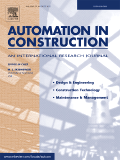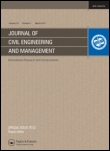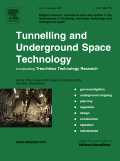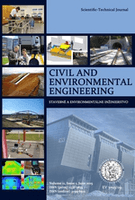
Gallerie e Grandi Opere Sotterranee
Scope & Guideline
Illuminating the World of Underground Heritage
Introduction
Aims and Scopes
- Tunneling Engineering and Technology:
Focus on the latest advancements in tunneling technologies, including mechanized excavation methods such as Tunnel Boring Machines (TBMs), and their applications in various geological contexts. - Infrastructure Development and Management:
Exploration of significant infrastructure projects, particularly large-scale tunnels and rail systems, highlighting planning, construction techniques, and project management. - Safety and Risk Management:
Research on safety protocols, risk assessment methodologies, and accident prevention strategies in tunnel construction and operation. - Sustainability and Environmental Impact:
Investigation into sustainable practices in tunneling, including the use of eco-friendly materials and technologies that minimize environmental impact. - Innovative Materials and Techniques:
Discussion of new materials, such as fiber-reinforced concrete and geosynthetics, and their role in enhancing the durability and performance of underground structures.
Trending and Emerging
- Artificial Intelligence and Automation in Tunneling:
An increasing number of papers explore the integration of AI and automation in tunneling operations, focusing on predictive maintenance, safety enhancements, and operational efficiencies. - Digital and Remote Monitoring Technologies:
Emerging themes around the use of digital tools, such as InSAR and other monitoring technologies, are gaining importance for their role in ensuring safety and structural integrity during construction. - Sustainable Practices in Tunneling:
There is a growing emphasis on sustainability, with research focusing on low-carbon materials, energy-efficient construction methods, and the environmental impact of tunneling projects. - Cybersecurity in Infrastructure:
The intersection of cybersecurity and tunneling is becoming a critical area of interest, as digitalization in construction raises concerns regarding data security and operational risks. - Advanced Numerical Modeling Techniques:
Innovative numerical modeling approaches for simulating ground behavior and TBM interactions are increasingly featured, reflecting advancements in computational methods within the field.
Declining or Waning
- Historical Overview of Tunneling:
There has been a noticeable decrease in publications focusing exclusively on historical tunneling techniques and projects, as the field increasingly prioritizes modern innovations and practices. - Conventional Tunneling Techniques:
As mechanized methods become more widespread, traditional tunneling techniques are discussed less frequently, indicating a shift towards advanced technology and automation. - General Discussions on Tunneling:
Papers that provide broad overviews without specific case studies or innovative insights are becoming less common, as the journal emphasizes detailed research and practical applications.
Similar Journals

JOURNAL OF PERFORMANCE OF CONSTRUCTED FACILITIES
Empowering Professionals with Cutting-Edge Performance InsightsJOURNAL OF PERFORMANCE OF CONSTRUCTED FACILITIES, published by the ASCE-AMERICAN SOCIETY OF CIVIL ENGINEERS, is a leading peer-reviewed journal dedicated to the field of civil engineering with a strong emphasis on the performance assessment and sustainability of constructed facilities. Established in 1987 and converging through 2024, this journal has garnered a solid reputation with an impressive Q2 quartile ranking across key areas including Building and Construction, Civil and Structural Engineering, and Safety, Risk, Reliability and Quality. The journal's Scopus rankings further underline its significance, being positioned within the top percentiles of these domains. As it aims to publish innovative research, case studies, and reviews, the journal serves as a vital resource for professionals and academics who are keen on advancing their understanding of the complexities associated with the performance and reliability of civil infrastructure. Researchers and practitioners interested in the latest advancements in construction performance can greatly benefit from the insights and findings published in this esteemed journal.

ACI STRUCTURAL JOURNAL
Unveiling the Future of Building with Scholarly ExcellenceThe ACI Structural Journal, published by the American Concrete Institute, serves as a premier platform for scholarly articles and research findings in the fields of building and construction and civil and structural engineering. With a commitment to advancing concrete technology and its applications, this journal has amassed an impressive reputation, holding a Q2 ranking in both Building and Construction and Civil and Structural Engineering categories as of 2023. The journal’s focus on innovative research and practical applications enables professionals, researchers, and students to stay at the forefront of industry developments. Although it does not offer open access, the content bears significant impact, ensuring that readers engage with high-quality research. As the journal converges its years of publication from 1987 to 2024, it continues to enrich the academic and professional discussions surrounding structural engineering and concrete science.

CANADIAN JOURNAL OF CIVIL ENGINEERING
Exploring the Intersection of Engineering and EnvironmentCanadian Journal of Civil Engineering, published by Canadian Science Publishing, serves as a premier platform for the dissemination of innovative research and development in the fields of civil and structural engineering, as well as environmental science. Established in 1971, this journal maintains a robust reputation, achieving a Q3 ranking in both civil engineering and general environmental science categories as of 2023. While it does not currently offer open access, the journal is accessible to a wide audience of researchers, professionals, and students who are keen to stay abreast of the latest advancements in civil engineering practices. With a significant number of yearly publications and a committed editorial board, the Canadian Journal of Civil Engineering contributes to the foundational knowledge and practical applications in the engineering community, thereby playing a critical role in addressing contemporary challenges in civil infrastructure and environmental sustainability.

Underground Space
Illuminating the Hidden World of InfrastructureUnderground Space is a distinguished academic journal dedicated to the multidisciplinary field of underground engineering and geotechnical science. Published by KEAI PUBLISHING LTD, this open-access journal has been contributing to the knowledge base since 2016, ensuring that research findings are accessible to a global audience. With an impressive Q1 ranking in categories such as Building and Construction, Civil and Structural Engineering, and Geotechnical Engineering, it reflects the journal's high impact and relevance within the academic community. The journal's Scopus rankings further signify its reputation, standing 16th in both Earth and Planetary Sciences and Engineering, and reaching the 93rd percentile in Geotechnical Engineering and Engineering Geology. Researchers, professionals, and students alike rely on Underground Space as a key resource for exploring the complexities of underground environments and infrastructure development. With its goal to advance knowledge in underground construction and sustainability practices, this journal is essential for anyone engaged in related research and practice.

Advances in Concrete Construction
Building Tomorrow's Structures TodayAdvances in Concrete Construction, published by TECHNO-PRESS in South Korea, is a pivotal academic journal dedicated to the fields of Building and Construction, Civil and Structural Engineering, and Mechanics of Materials. Established with the aim of fostering innovative research, this journal has rapidly gained recognition, achieving a commendable Q2 ranking across multiple categories, including Safety, Risk, Reliability, and Quality as of 2023. Featuring a blend of rigorous peer-reviewed articles, the journal serves as a vital platform for scholars, engineers, and students alike to disseminate cutting-edge research and practical applications in concrete construction technologies. Despite its absence of Open Access, the journal's inclusion in Scopus with notable rankings - such as #66 in Building and Construction - underscores its growing influence and commitment to quality as it converges on significant advancements from 2016 to 2024. By contributing to this respected journal, you join a community dedicated to exploring the future of sustainable and efficient construction practices.

AUTOMATION IN CONSTRUCTION
Driving Efficiency and Innovation in the Construction IndustryAUTOMATION IN CONSTRUCTION is a premier academic journal published by Elsevier, dedicated to advancing the fields of Building and Construction, Civil and Structural Engineering, and Control and Systems Engineering. Since its inception in 1992, this journal has served as a vital platform for disseminating innovative research and practical applications in automation technologies within the construction industry. With a distinguished 2023 impact factor reflected in its Q1 ranking across multiple engineering categories—securing rank #3 in Civil and Structural Engineering and rank #3 in Building and Construction—AUTOMATION IN CONSTRUCTION stands out as a leading resource for researchers, professionals, and students keen on staying at the forefront of this rapidly evolving field. The journal offers access to cutting-edge studies that explore automation processes, methodologies, and tools, contributing to the enhancement of productivity and sustainability in construction practices. With contributions from global experts, each issue of AUTOMATION IN CONSTRUCTION provides comprehensive insights that help drive innovation and foster collaboration.

Journal of Civil Engineering and Management
Transforming ideas into impactful engineering solutions.Journal of Civil Engineering and Management, published by Vilnius Gediminas Technical University in Lithuania, is a prominent open access journal dedicated to the dissemination of cutting-edge research in both civil and structural engineering as well as strategic management. With the ISSN 1392-3730 and E-ISSN 1822-3605, this journal has been an essential resource for academics and industry professionals since its inception in 2002 and has continued through to 2024. Recognized for its high-quality publications, it ranks in the Q2 quartile in both the fields of Civil and Structural Engineering and Strategy and Management, reflecting its significant impact in the academic community with a Scopus ranking of #75 out of 379 and #121 out of 478 respectively. The journal embraces an open-access model, promoting wider distribution and accessibility of knowledge to foster innovation and collaborative advancements in construction practices and management strategies. It serves as a vital platform for researchers, professionals, and students looking to contribute to and stay informed about the latest developments in these dynamic fields.

TUNNELLING AND UNDERGROUND SPACE TECHNOLOGY
Pioneering Innovations in Underground Engineering.TUNNELLING AND UNDERGROUND SPACE TECHNOLOGY, published by Pergamon-Elsevier Science Ltd, stands at the forefront of research in the fields of tunnelling, underground construction, and geotechnical engineering. With the high reputation reflected in its prestigious Q1 status in both Building and Construction and Geotechnical Engineering and Engineering Geology quartiles, this journal serves as an essential platform for pioneering studies and innovative practices. The journal has demonstrated a notable impact in the academic community, evidenced by its impressive Scopus rankings, with an esteemed rank of #7 in Geotechnical Engineering out of 229 journals, placing it in the 97th percentile. This positions it as a vital resource for researchers and professionals seeking the latest advancements in underground space technology. Published since 1986 and continuing through 2024, the journal aims to disseminate cutting-edge research that enhances both the science and practice of tunnelling, providing a significant repository for students and experts eager to advance their understanding and expertise in this critical area of engineering.

Innovative Infrastructure Solutions
Leading the Charge in Sustainable Engineering Practices.Innovative Infrastructure Solutions is a leading academic journal published by Springer International Publishing AG, focusing on pioneering advancements in the fields of building and construction, civil and structural engineering, and environmental engineering. With an impact factor that reflects its significant role in the academic community, this journal serves as a vital platform for researchers, professionals, and students to disseminate groundbreaking studies and novel methodologies spanning diverse engineering disciplines. Since its inception in 2016, Innovative Infrastructure Solutions has steadily positioned itself within the Q2 category across several fields, including geotechnical engineering and engineering geology, as recognized in the 2023 quartiles. This reputable journal, accessible from Switzerland, not only emphasizes collaboration and knowledge exchange but also empowers innovators in infrastructure development globally. Whether you're contributing to a research project or seeking the latest findings, Innovative Infrastructure Solutions remains essential for anyone invested in advancing sustainable infrastructure solutions.

Civil and Environmental Engineering
Transforming challenges into engineering breakthroughs.Civil and Environmental Engineering, published by SCIENDO, is a prominent open-access journal dedicated to advancing research and knowledge in the fields of civil and structural engineering, as well as environmental engineering. Since its inception in Germany, it has been committed to promoting cutting-edge studies and methodologies that address the pressing challenges in these domains. With an ISSN of 1336-5835 and E-ISSN of 2199-6512, the journal is accessible to a global audience, having adopted an open-access policy since 2014 to enhance the visibility and dissemination of scholarly work. The journal currently holds a Q3 ranking in both Civil and Structural Engineering and Environmental Engineering, as of 2023, reflecting its growing influence within the academic community. It operates within a framework of rigorous peer-review standards and encourages contributions that not only contribute to theoretical advancements but also have practical implications for real-world applications. Researchers, professionals, and students alike will find invaluable insights and innovative perspectives in the latest studies published from 2018 to 2024.